Apple iOS 5 Review
by Vivek Gowri, Andrew Cunningham, Saumitra Bhagwat & Brian Klug on October 18, 2011 3:05 AM ESTNotifications and the Notification Center
At first glance notifications on a locked iOS device appear to be simply restyled. Instead of a blue popup with white text you get a black popup with white text - and an app icon. Unlike previous versions of iOS however, multiple notifications now appear in a list on the lock screen rather than simply replacing the notification that was there previously.
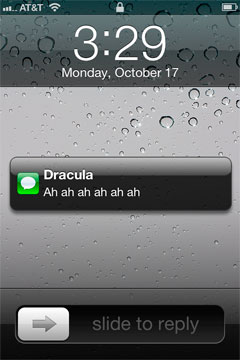

The list of notifications can get very long (we didn't test to see if it would ultimately stop, but you can now display at least 30 notifications on the lock screen) and iOS 5 allows you to scroll through them:
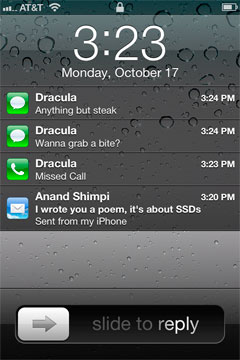

This feature alone is worth the upgrade to iOS 5 as it's a huge improvement in usability. You can now quickly get the gist of any SMS conversation and ensure there are no urgent emails that need tending to with a quick glance at your locked phone. Interacting with notifications from the lock screen is also improved, you can now slide over any notification to address it specifically:
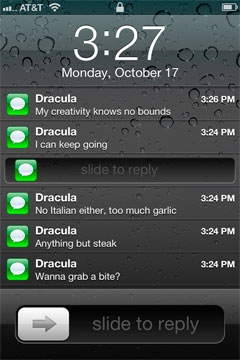


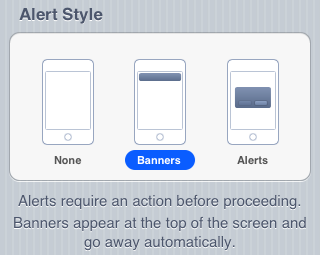
Swiping a finger down from the top of the screen reveals the new Notification Center, where your active notifications are all listed (some apps, like Weather and Stocks, can also display permanent widgets here if desired). Notifications are listed by app, and will disappear from the Notification Center once addressed or cleared manually by the user.
Pulling down the notification shade in a full screen app is a two-step process: pull once to reveal a tab and pull twice to reveal the shade. Apple does this to avoid any accidental shade activation.

The number of notifications per app in the Notification Center is customizable:

On the iPad, Notification Center works mostly like it does on the iPhone - although obviously occupying less of the screen:
The impact of the revamped notification system is arguably even more pronounced on the iPad as the previous system was a significant burden to productive use of the tablet.
The verdict? None of these features are exactly new to smartphones (Android users, especially, will note many similarities to the notifications shade) but the implementation is smooth and it really goes a long way toward making iOS more pleasant to use - the best software upgrades make you wonder how you got by without the improvements they bring, and the notification improvements achieve that goal.


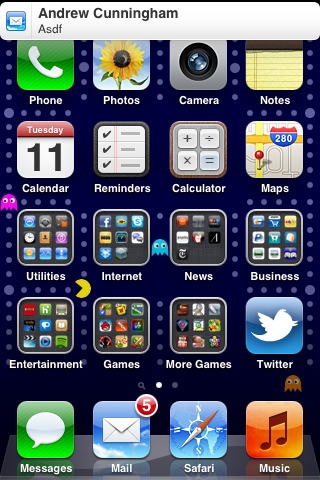
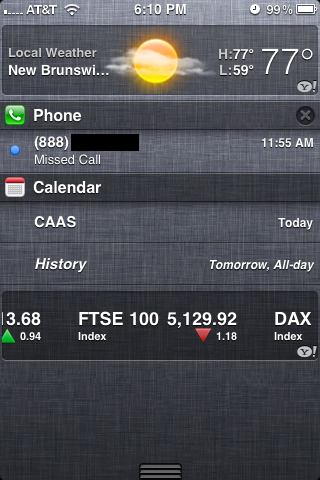









86 Comments
View All Comments
Brian Klug - Tuesday, October 18, 2011 - link
That's true, however we've measured and talked about the size of iMessage messages - read/delivery reports are 53 bytes (which is literally almost entirely just overhead from JSON and APNS), and messages range upwards in size from there up to 853 bytes before being fragmented across a few different APNS.By that math, it's going to take 245,856 maximum length (853 byte) iMessages to eat up your 200 MB data plan.
-Brian
steven75 - Monday, October 31, 2011 - link
iMessage defaults back to SMS if it hasn't been sent after X seconds. In theory, this means you shouldn't have to worry about congestion because Apple thought of this for you.FoTacTix - Tuesday, October 18, 2011 - link
I was hoping for a battery life comparison in the review. Maybe I missed it? My battery life seemed to be much worse with imessage turned on on my Verizon iPhone 4.Dug - Tuesday, October 18, 2011 - link
Great review!The most important update for me was mirroring to the Apple TV, and I think Apple would sell millions of Apple TV's if they promoted this.
I enjoyed airplay before, but now that it works with every app is incredible.
I enjoy being able to put everything through my stereo and TV. Things like Pandora, MOG, videos, games, etc. is so nice and very easy. Garage Band is actually fun now that I don't have to plug into my stereo. No other product can come close to this. I have several Apple TV's now throughout the house and can control everything from my iPad.
It makes me wish that they made a 16x9 iPad. (But with my TV's I'm able to do a little stretch so it's not so bad)
jsd6 - Tuesday, October 18, 2011 - link
You can easily delete items from Reading List - swipe to delete on iphone/ipad, click the "X" icon on desktop Safari.You can do Wifi sync without being plugged in - it just isn't automatic. The wording on the iDevice is definitely confusing. As soon as your device is within wifi range of your Mac, the device will show up in iTunes as if it were connected via a cable. You can click Sync on iTunes, or initiate it from the phone. I've actually found to be too slow for my tastes so I stick with the cable. At least now the phone is still usable while the syncing is happening. That's a big step in the right direction!
Galatian - Tuesday, October 18, 2011 - link
The one thing that really made me angry about the iOS update was the removal of the multitouch gestures for iPad 1 owners. I mean it worked in iOS 4 through an Xcode developer account, so Apple can't even say that the hardware is not powerful enough, like they do with Siri.What is even worse is the fact that they changed their website AFTER the update has been releases and people started complaining on their support forum. Now the American site states it is an iPad 2 feature only. Strangely enough the UK, Canadian, German, ... still quote the general iPad.
Also the change log for iOS 5 update never mentions this to be an iPad 2 only feature.
Apple has been known to artificially outdate their products, but they have down so quietly. This time they actually announced something and are now quietly changing stuff so it fits their business model...dumb move if you ask me.
steven75 - Monday, October 31, 2011 - link
I agree there was not a good reason to do that. I wouldn't want to be without multitouch gestures on an iPad. I never use the home button except to turn it on.lurker22 - Tuesday, October 18, 2011 - link
So there is no fix?I have to remember to send messages to people using their email address in order for it to be sure and deliver to all their iOS device? Which means I have to know what phones all my friends use which is nuts.
Why doesn't iMessage just route imessages sent to a cell number to all the values associated with the apple ID?
name99 - Friday, October 21, 2011 - link
Truth is, there are a HUGE number of rough edges associated with iCloud and all the related services. A different set of examples would be the duplicates of events in calendars, or the duplicates of contacts in Address Book; and there is no consistent mental model for how data is supposed to behave "in the cloud and on devices". Mail behaves one way, calendars and contacts another, iTunes music a third --- and I don't think any human understands how Notes are supposed to behave.My HOPE is that this is all teething troubles --- Apple was faced with a deadline --- they needed to get iPhone 4S out by a certain date --- and iCloud was rushed before various bits were quite ready. If this is so, hopefully we'll see the worst discrepancies resolved in iOS5.1 and OSX 10.7.3 in three months or so.
And if not --- well, that is NOT a good sign. Apple's whole value proposition is, of course, "it just works". And while Android seem unlikely to compete on that front soon, it is possible (not inevitable, but possible) that MS might actually get it right in Win 8, right enough at least to become the new press darling, the company whose cloud offerings make sense, unlike Apple whose every product behaves poorly and inconsistently across the cloud.
unixfg - Wednesday, October 19, 2011 - link
I don't really understand your claim here:"So regardless of how and where you’ve gotten your music from, if its there on the iTunes Store, it automatically gets legalized and added to your account..."
Do you mean to imply there is no distinction on Apple's servers as to the source of your Music? I know the AAC files you buy have a tag linking it to your account, and can't imagine they wouldn't keep track of the source.
That aside, I don't see how it would "legalize" anything. I'm a huge fan of your articles, and hate that this is the first time I've felt the need to register and comment, but...
<citation needed>